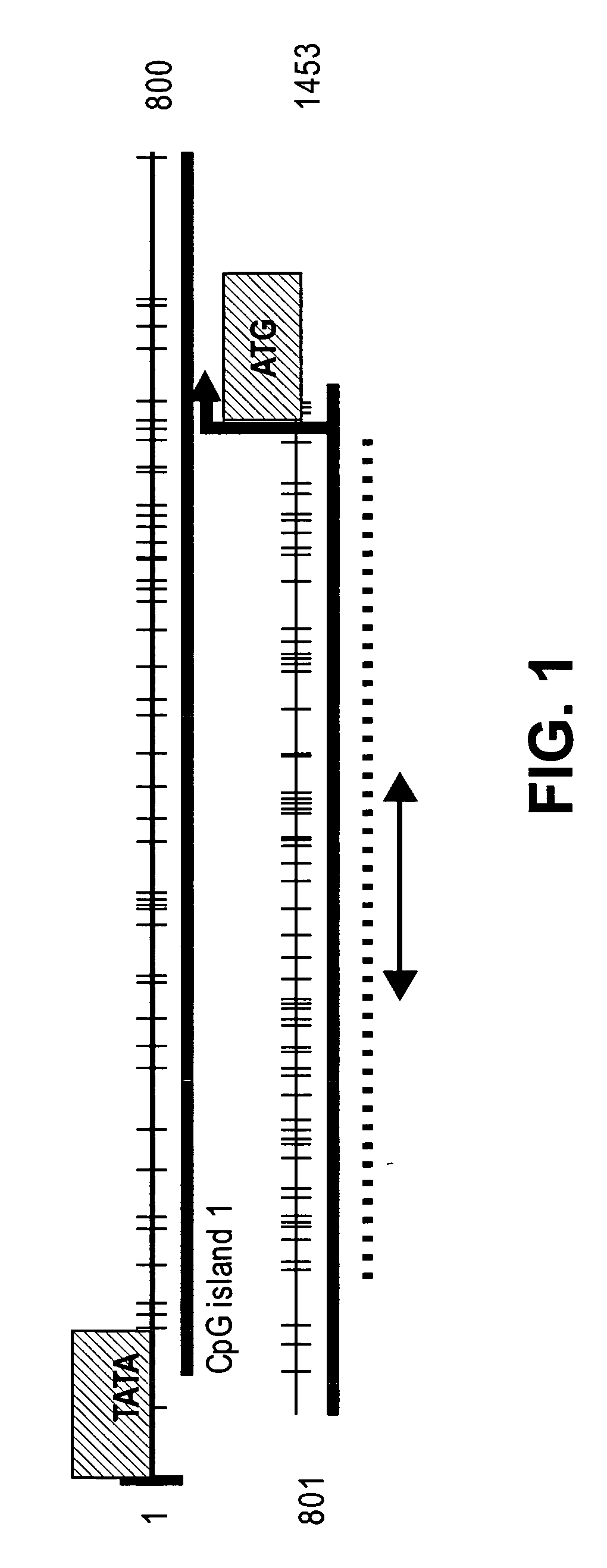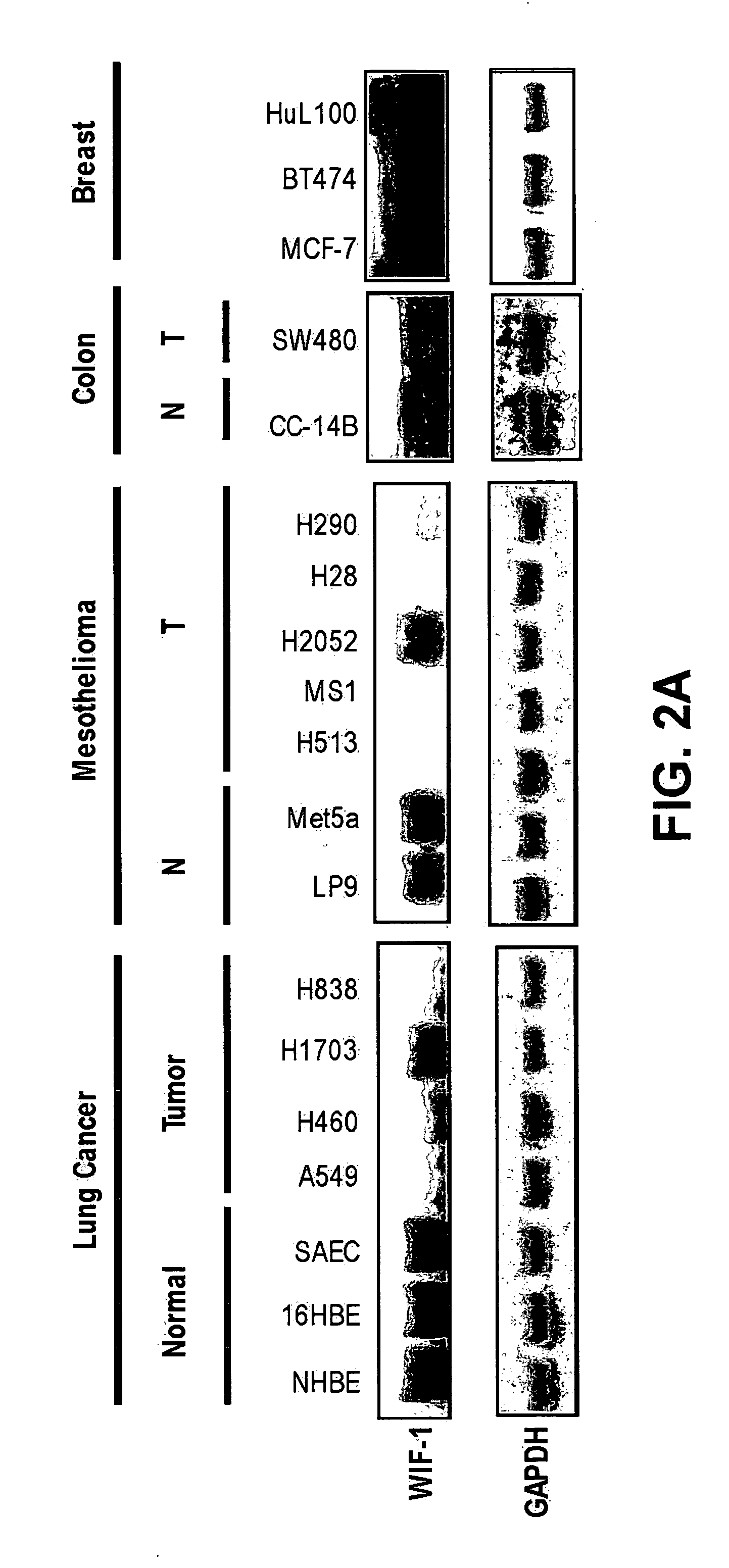Methods for treating and diagnosing cancer with WNT inhibitory Factor-1 (WIF-1)
a technology of inhibitory factor and cancer, which is applied in the field of methods for treating and diagnosing cancer with inhibitory factor1, can solve the problems of not being able to find markers for most cancers, and the overall five-year survival rate of nsclc is only 15%
- Summary
- Abstract
- Description
- Claims
- Application Information
AI Technical Summary
Benefits of technology
Problems solved by technology
Method used
Image
Examples
example 1
General Methods
[0307] A. Cell Lines and Tissue Samples
[0308] NSCLC cell lines (NCI-H1703, NCI-H460, NCI-H838 and NCI-A549), melanoma cell line LOX, hepatocellular cancer cell lines SNU398, and colorectal cancer cell line HCT116 were obtained from American Type Culture Collections (ATCC; Manassas, Va.) and cultured in RPMI 1640 supplemented with 10% fetal bovine serum, penicillin (100 IU / ml) and streptomycin (100 μg / ml). Normal human small airway epithelial cells (SAEC) and bronchial epithelial cells (NHBE, 16HBE) (primary cultures) were obtained from Cambrex Bio Science Walkersville, Inc. (Walkersville, Md.) or Clonetics (Walkersville, Md.) and cultured in Clonetics SAGM™ Bullet Kit. All cells were cultured at 37° C. in a humid incubator with 5% CO2.
[0309] Fresh lung cancer tissues and adjacent normal lung tissues from patients undergoing resection for lung cancers were collected at the time of surgery, and immediately snap-frozen in liquid nitrogen (IRB approval H8714-15319-040)...
example 2
Identification of the WIF-1 Promoter Region
[0338] To identify the WIF-1 promoter, a BLAST search was conducted using the 1140-bp coding sequence of WIF-1 as a virtual probe against the human genomic database at the UCSCr. A promoter search program was used to confirm that the 5′ region of the gene presents classical features of a promoter region. In addition, a CpG island search program was used to map the CpG islands within the WIF-1 promoter (FIG. 1). 105 CpGs in this promoter region (1.2 kb before the ATG of the WIF-1 open reading frame) were identified.
example 3
Functional Analysis of the Human WIF-1 Promoter with Deletion Mutants
[0339] To study the promoter activity the complete 1 kb fragment (ahead of the ATG) as well as five truncated fragments were cloned into a promoterless luciferase (LUC) expression vector pGL3Basic. 293T cells were transfected with those constructs and examined LUC activities. The complete wild type construct (construct 1) displayed a very high basal activity (approximately 200-fold increase of LUC activity compared to that of the empty vector which was set to unity).
PUM
| Property | Measurement | Unit |
|---|---|---|
| Tm | aaaaa | aaaaa |
| Tm | aaaaa | aaaaa |
| temperature | aaaaa | aaaaa |
Abstract
Description
Claims
Application Information
 Login to View More
Login to View More - R&D
- Intellectual Property
- Life Sciences
- Materials
- Tech Scout
- Unparalleled Data Quality
- Higher Quality Content
- 60% Fewer Hallucinations
Browse by: Latest US Patents, China's latest patents, Technical Efficacy Thesaurus, Application Domain, Technology Topic, Popular Technical Reports.
© 2025 PatSnap. All rights reserved.Legal|Privacy policy|Modern Slavery Act Transparency Statement|Sitemap|About US| Contact US: help@patsnap.com



